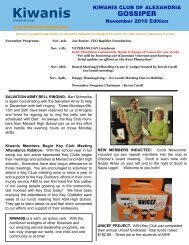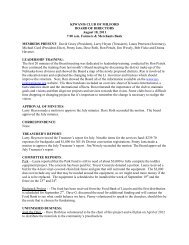The Kiwanis Club of Delray Beach - Sunrise - KiwanisOne.org
The Kiwanis Club of Delray Beach - Sunrise - KiwanisOne.org
The Kiwanis Club of Delray Beach - Sunrise - KiwanisOne.org
Create successful ePaper yourself
Turn your PDF publications into a flip-book with our unique Google optimized e-Paper software.
<strong>The</strong><br />
PUBLIC SERVICE ANNOUNCEMENT<br />
Friends Still Let Friends Drive Drunk<br />
On Sept. 15, Matthew Grape, 21, got into the passenger seat <strong>of</strong> a<br />
car with one <strong>of</strong> his Duke University fraternity brothers. <strong>The</strong> driver<br />
hit a tree, escaping with minor injuries, but killing his dear friend.<br />
According to local press reports, the driver was charged with<br />
impaired driving.<br />
Nearly 11,000 deaths related to alcohol-impaired driving still<br />
occur each year in the United States, despite a three-decade<br />
surge in anti-drunken driving activism, stricter laws and clever<br />
slogans like “Friends don’t let friends drive drunk.” <strong>The</strong>re are<br />
more than 110 million instances <strong>of</strong> impaired driving each year,<br />
according to data from the Behavioral Risk Factor Surveillance<br />
System Survey and summarized in a new report from the Centers<br />
for Disease Control and Prevention.<br />
How can this still be occurring, and what can be done about it?<br />
Too many young people still climb into cars after drinking, despite<br />
hearing countless admonitions against drunken driving in health<br />
classes in high school and from their parents and friends.<br />
Adolescent feelings <strong>of</strong> invulnerability no doubt play a role. But<br />
other, more subtle reasons probably contribute as well.<br />
Binge drinking at colleges remains a huge problem. Despite public<br />
health campaigns to eliminate drinking on campuses, the alcohol<br />
industry continues to sponsor events, and provocative<br />
advertisements persist. Men ages 21 to 34 and binge drinkers <strong>of</strong><br />
all ages are those most likely to drive while drunk.<br />
In addition, scientifically proven methods for lowering drunken<br />
driving deaths are being underused, as the C.D.C. report points<br />
out. <strong>The</strong>se include sobriety checkpoints, in which drivers are<br />
stopped to assess their level <strong>of</strong> alcohol impairment. Twelve states<br />
don’t use them at all, while many others underuse them. Ignition<br />
interlocks, which prevent those who have been drinking from<br />
starting their cars, are used for only one in five persons convicted<br />
<strong>of</strong> driving while intoxicated, although they lower the rate <strong>of</strong><br />
subsequent arrests by two-thirds. Designated drivers have<br />
become more commonplace, but they are much more socially<br />
accepted in other countries like Sweden and Australia.<br />
Finally, and ironically, the recent focus on distracted driving, in<br />
which drivers text or speak on their cellphones, may have<br />
distracted our attention from drunken driving. Both are enormous<br />
public health problems.<br />
Some might argue that measures to control drunken driving in<br />
the United States have been remarkably successful. After all, the<br />
number <strong>of</strong> people who will die because <strong>of</strong> alcohol-related crashes<br />
this year is less than half what it was 30 years ago.<br />
But it is unlikely that the families <strong>of</strong> thousands <strong>of</strong> other victims <strong>of</strong><br />
drunken driving would agree. Drunken driving remains among the<br />
most preventable <strong>of</strong> violent injuries. Every time we lose a young<br />
person — or an old person — to this crime, it is as tragic as it was<br />
in 1980.<br />
<strong>The</strong> <strong>Kiwanis</strong> <strong>Club</strong> <strong>of</strong> <strong>Delray</strong> <strong>Beach</strong> - <strong>Sunrise</strong> Page 6<br />
Upcoming Meeting Programs<br />
December 5 Homeless Count<br />
December 12 “Need a program”<br />
December 19 <strong>The</strong> Lord's Place<br />
December 26 New Year's Wishes<br />
January 2 Vet's Place<br />
January 9 Campaign for<br />
Grade Level Reading<br />
January 16 F<strong>org</strong>otten Solider<br />
Please contact Ezra Krieg,<br />
954-260-8838 if you have a program<br />
idea for our meetings.<br />
Did You Know……?<br />
Let’s end bullying<br />
If you have something for the newsletter, please<br />
send it to Scott Youngberg via E-mail:<br />
esysy@comcast.net<br />
Bullying hurts. In 2011, the Centers<br />
for Disease Control and Prevention<br />
reported that 20 percent<br />
<strong>of</strong> American teens in grades 9-12<br />
had been bullied on school<br />
grounds in the past year.<br />
<strong>The</strong> bullying epidemic is more<br />
widespread than we think. Six<br />
out <strong>of</strong> 10 youth in the United<br />
States alone witness bullying at least once a day, and<br />
thousands <strong>of</strong> students see school as a place <strong>of</strong> fear rather<br />
than fun and learning.<br />
<strong>The</strong> good news: This epidemic isn’t immune to support<br />
from the <strong>Kiwanis</strong> family.<br />
Through <strong>Kiwanis</strong> and its service leadership programs for<br />
youth—K-Kids for elementary school, Builders <strong>Club</strong> for<br />
middle school and Key <strong>Club</strong> for high school—we can make<br />
our schools safe zones for all students. Youth who are<br />
members <strong>of</strong> these programs learn compassion, teamwork<br />
and responsibility through service learning, and are less<br />
likely to bully other students or be bullied themselves.<br />
Want to help end bullying? First, read <strong>Kiwanis</strong>’ position on<br />
bullying and hazing. <strong>The</strong>n print out one <strong>of</strong> our antibullying<br />
posters and get permission to hang it up at a local<br />
school or community center. Check out our resources<br />
to learn more about how you can get involved in the antibullying<br />
movement. Join the fight. End bullying.<br />
Also, you can go to www.kiwanis.<strong>org</strong>/bullyprevention<br />
Thank you
















